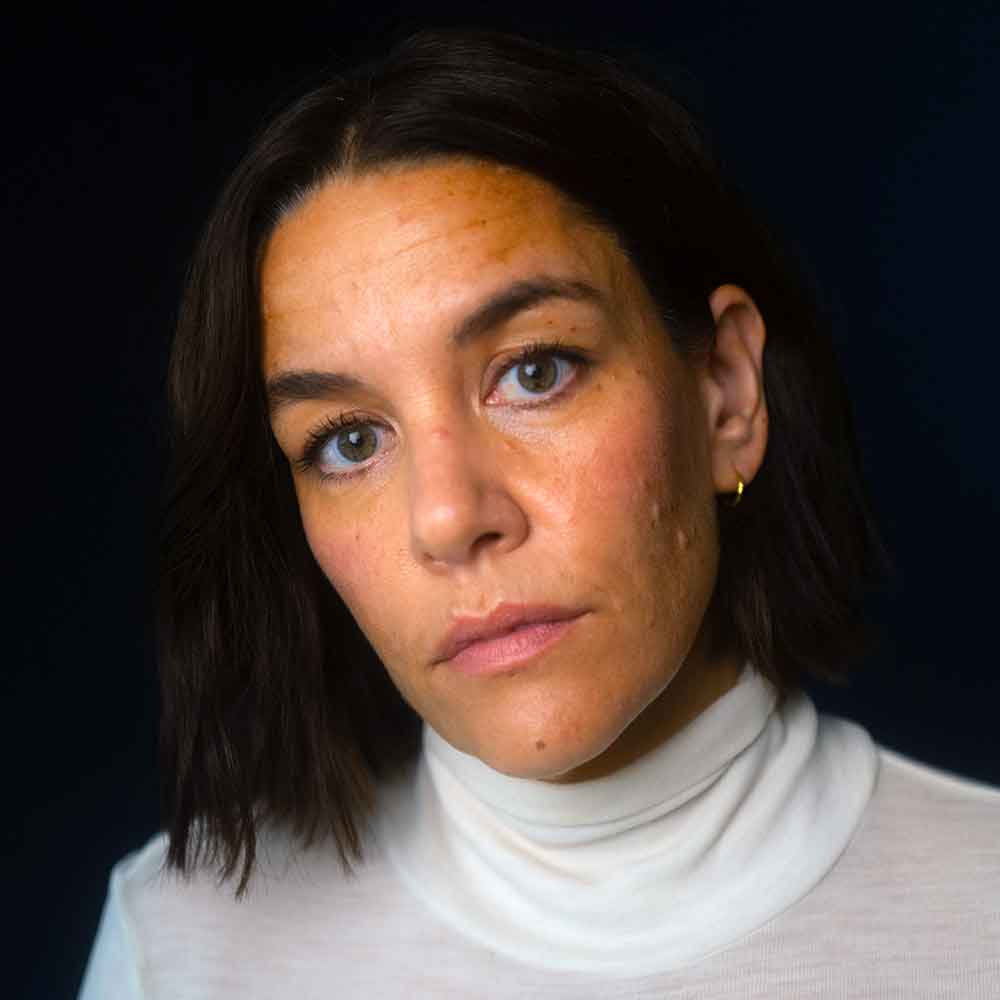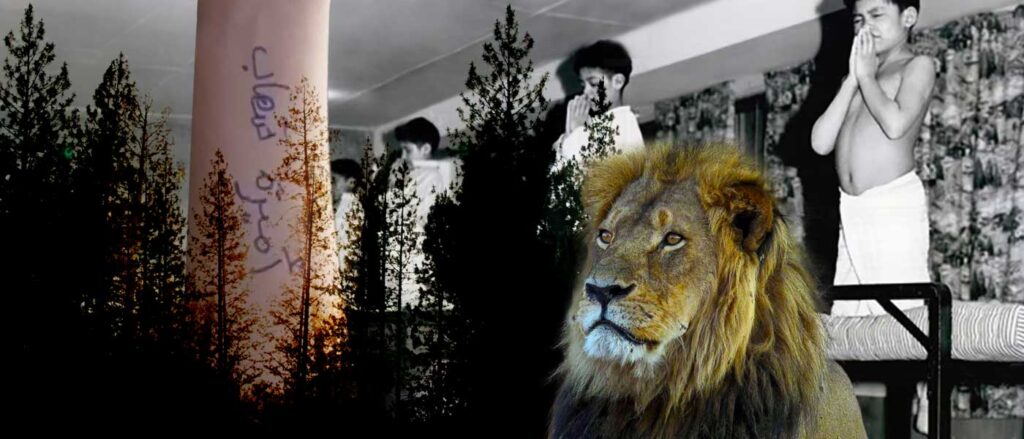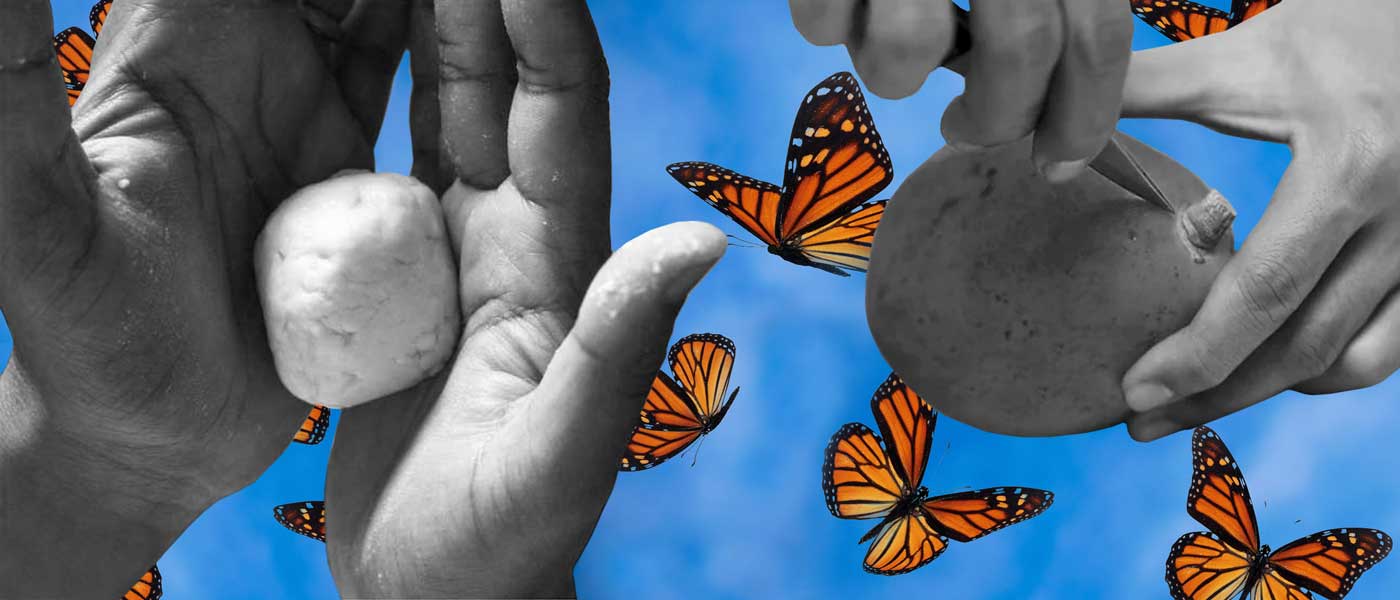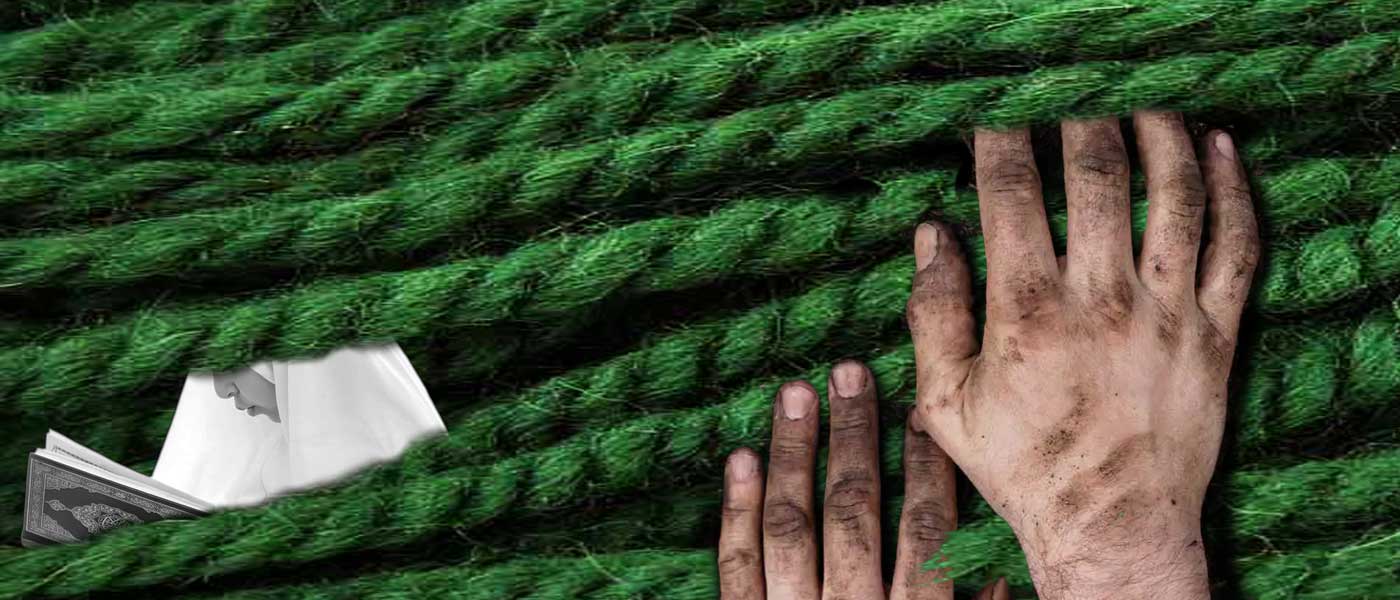The American dentist who shot Cecil the Lion once said, If I had known this animal had a name … I obviously wouldn’t have killed it.
When I was eight years old, my uncle teased me because I didn’t know how to pronounce my own name. It was an injury that I have never fully recovered from. We were all crowded around the kitchen table one Saturday morning, legs pressed against one another’s, waiting for family breakfast to begin. My father had pushed a plate of fatty eggs onto the table, next to a basket of pita bread cut into limp triangles. The phone rang just before we started eating. I climbed down from my chair and answered it the way my father had taught me to: Hello, Monem residence.
When I got back to the table, my uncle laughed and said, Why did you say our name like that?
It was the 1990s. He had been trying all winter to make his laugh sound like Eddie Murphy’s. It was working. That’s not how you say it.
(More laughing.)
That’s not even our name.
My brother Chris, or Walid — depending on who was asking — came to my defense. No that’s right, he said, Mow-nemm. My other brother Alex, or Rami — depending on who was asking — raised a mocking eyebrow and said, No it’s not, it’s Maw-nem. My uncle Hossam or Sam — depending — laughed again and told them they were both wrong. No, it’s Moh-niem. I felt my father’s long-fingered hand on my arm then, and everyone went quiet. My father said to me, It’s your name, you can say it however you like. Disoriented and embarrassed, I felt the heat rise up into my cheeks. I didn’t want the freedom to say my name however I liked — I wanted to know how to say it right.
Whatever the “correct” pronunciation supposedly was, my uncle was right to reject its reality. It wasn’t real if a last name’s realness lies in its connection to generations, if it is meant to serve as a tether through time — both a kind of memory-keeping and a form of constitutional address: this is, I am, they are. I would only learn years later, when I was in high school, or maybe even after, that the name that is now my name was invented by my father during his interview at the German embassy in Cairo sometime in the late 1960s. He’d been there to apply for his student visa, and his last name (my real last name) was too long to fit on the form they gave him. The clerk insisted that if my father wanted to emigrate to Europe, he had to choose a name that would fit on the form.
Arabic naming conventions go beyond the gesture of memory-keeping: they are explicit records of a family history — long, sometimes exhausting, often unutterable to the western tongue. My father was faced with the decision to either keep his name and be forever confined to his history, or to cut it short for the chance to be modern. He had been born in an Egypt still limping under the weight of British colonial rule, and even though he was still a young man, he had lived long enough to have his heart broken by revolution. Maybe that is why he chose the cut. Maybe he felt that whatever history was evoked by his name was already a ruin.
Confronted by my father’s choice at the breakfast table, by the awful weightlessness of my name, I suddenly found it hard to locate myself. My arms felt far away — or was it the table? I concentrated on my plate, on pinching up food with my bread. I pinched and ate and pinched and ate, and by the time I looked up again, the table was empty. Only the spent fūl platter kept me company, its galaxies of oil and vinegar catching rainbows in the midwinter sun.
Though & because it confuses the tongue,
Zeina Hashem Beck1
let me repeat this: the flowers are ours the flowers
are ours the flowers are ours
That afternoon, my uncle tried to make amends by inviting me to run errands with him. But despite the fact that it was one of my favorite things to do, I refused — still sulking. I watched him reverse out of the driveway alone soon after, leaving behind tracks of gray slush in the soft new snow. Staring through the window after him, I looked at the cluster of tall pines that stood in between our hastily-built house and our quiet suburban street at the edge of Toronto. It was a small congregation of trees left over from a time before so many hastily built houses were required. There was a humming silence in the house, punctured only by the turn of the washing machine. It was the kind of accusatory quiet that made me feel observed, and I was: every movement I made roused the attention of my father, who was playing solitaire at the kitchen table. I squinted at the hazy sun, oatmeal-coloured behind a veil of thin gray cloud. The days were short in midwinter, but there was still plenty of time to escape the silence of the house, plenty of snow outside to make a place to sit inside, unseen.
My father called out to me shortly after I decided I went to put on my snowsuit, asking me where I was going. I told him I was just going out front.
Alone? I nodded. Okay, he said, but the sun is already low. Remember the Jinn.
I would often ask my father about the Jinn, but no matter how patient his explanations might have been, the Jinn always shifted in my partial understanding. I didn’t know what to make of them, or how to imagine them. My madrassa teacher looked at me impatiently whenever I asked where they came from or how they lived. She told me that the Jinn are beings made of smokeless fire or hot wind, not earth and water like humans. She told me that they conceal themselves in trees or out-of-the-way places until sunset, when they roam the earth causing mischief, confusing and tricking people, taking them away, or worse. Looking at the low sun, I wondered if there were Canadian Jinn, or if they immigrated like my father did from Egypt — or perhaps from Sudan, or Palestine. I wondered if they had names, and how long their names were, and if our human tongues could pronounce them. I wondered if they wore clothes, if they had to wrap up warm against the winter chill, and if so, who made their clothes. If there was a whole shadowy Jinn economy we couldn’t see. And then I decided this was too much not to see and that the Jinn were things made up by fathers to keep their daughters inside.
I called to my father at the kitchen table, Baba, are the Jinn real?
He shrugged. They are mentioned in the Quran a few times.
I didn’t know if that meant that he thought they were real, or not.
The silence was different outside. Proud. Stretching out wide and returning from far away. I surveyed the space between the pines and dropped to my knees, pulling snow toward me, packing it down. I drew and rolled and packed and built up a curved wall just big enough to hold me, and then I set to work on the other side, arching the walls upward so that they fell just short of meeting. The blue-gray sky was barely visible through the almond-shaped aperture overhead. Lying on my back with my arms folded behind me, I listened to the wind sweep the snow from the branches above, the pine needles in quiet conversation. Further away, I could make out the dumb speed of the highway slicing through the earth and throwing brown slush on what bare patches of land remained.
Earlier that year, my third grade teacher had taught us that when Adam was in paradise, he was given the role of naming the animals. This astounded me, that a job as important as naming the animals was given to a human, and one so newly created. As an adult, I have often revisited that passage from the bible, but each time I am disappointed; the story is brief and insufficient, as if truncated from memory. It doesn’t list the names Adam chose for the animals, for instance, or how long they were, or what language he used to name them. Nor does it indicate whether the animals acknowledged their names, or if they had their own way of addressing one another. The passage only mentions how Adam named the animals based on his need and vantage point — what the animals were to him, what use they had. And of course there was no mention of the animals for which Adam had no use. While I am searching, I see various theological debates online about whether or not Adam’s naming of the animals was in fact an act of bringing the animals into being — of poesis, rather than onomasia.
As I am scrolling through various interpretations of this passage, I wonder about the name that is not my name, and what sort of new being it brought into existence, or what kinds of possibilities it foreclosed. It is a name that both constitutes and effaces me, tethering me to no one and nowhere. I wonder for whom it is most useful.
I didn’t know then that not far from where my eight-year-old self was lying on the snow-packed earth that day, watching my breath bloom into puffs of clouds in the weak winter light, the last residential school in Ontario was winding down its official functions, preparing to close its doors for good. For over one hundred and fifty years, residential school systems operated throughout Canada, designed to annihilate Indigenous languages, kinships, and futures. In 1920, The Indian Act required by law that all Indigenous children attend these institutions. Some families would attempt to hide their children, even though they could face prosecution, or risk being denied the treaty payments they depended on for survival. Some parents were starving because their hunting and fishing rights had been taken away, and they reluctantly sent their children to these schools because their children were starving too. The Royal Canadian Mounted Police would come by train or by truck or by dogsled to round up the children. Sometimes they would tie them up to stop them from struggling, gathering more and more children as they sped through community after community, nation after nation.
When they arrived at their new schools, the children were separated from their siblings and other relatives, bathed in hot water, given thin European clothes, and forbidden from speaking their language. Because language is a body that can resist. The children would also have their hair cut short, an act reserved for mourning in many Indigenous traditions. Within those customs, the length of hair cut often signifies the length of time spent with a departed loved one — the closer the relation, the closer the cut.
Residential school survivor Daniel Kennedy (or, Ochangkuga’he) recounted his arrival at the Qu’Appelle school in Saskatchewan in his memoir, Reflections of an Assiniboine Chief. In it, he described the horror he felt at seeing his hair shorn so close to his scalp, and how he wondered, silently, if it was cut so short because his mother had died. He didn’t have the language to ask the nuns who were handling him with such efficient cruelty, and so he quietly wept. The principal at the Qu’Appelle residential school then asked Ochangkuga’he’s for his name, and when it was given, the principal remarked that there were no letters in the alphabet to spell it, and no civilized tongue could pronounce it. It was then that Ochangkuga’he’s name was erased, and in its place a new English name was entered into the school’s entry form. The institution that Ochangkuga’he was forced to attend was named after what is now called the Qu’Appelle River in Saskatchewan, a French phrase that means Who Calls? The French name is a misunderstanding of the Cree name for the river: Kah-tep-was, or River that Calls. The French is framed as a question, to which an answer is already given.
I can’t tell you anything new about the river—
Natalie Diaz2
you can’t tell a river to itself.
In my temporary shelter of snow underneath the pines, the walls were tingeing purple, and the clouds overhead were becoming more pronounced against the darkening pink sky. I whispered the name that was not my name again and again; stretched out its vowels, made them go slack, sharpened its consonants or smoothed them over. If my uncle told me our real family name that day, I didn’t remember it. That, or my western tongue could not pronounce it. He did tell me once that our inherited name is very old, older than most countries — certainly older than the country that granted me my citizenship at birth. How many generations old? I wondered. How did the first generations of our family say our name? What shape did their mouths make as they said it? I turned on my side and rested my head on my arm, tracing shapes on the wall of snow in the changing light. I drew circle after circle, connecting them up in a chain around me until it became too dark to see where to put the next loop.
All at once, the dangers of darkness occurred to me.
The sunset, and the Jinn, and the whispering, and the taking — I burst up through the snowy wall and scrambled to my feet, sliding my way through the small group of silhouetted trees between me and the front door, tripping and getting up again and running face-first into a low hanging branch. The skin on my lip, cold-hardened and dry, slid easily apart. I felt a stream of blood warm my chin, dripping in heavy black spots through the perfect white snow. I watched as the drops fell, unable to find the words to call out, wondering if this was how the Jinn would find me — face covered in blood and body frozen in panic, only steps from my front door. Or maybe this is how the Jinn left me, unsteady on my feet and without the language to help myself. The pain of my lip brought me back to my body, and I held a mitted hand to my face, listening to the wind, and for any new words it might contain. Then, I picked my way carefully across the driveway back to the house. I did not look back.
Many of the children that were taken to residential schools didn’t come home again. Generations of families have lived within the cold expanse of not knowing what happened to their children, or not recognizing the children who returned to them with new names and the language taken out of their mouths, forever changed by abuse and neglect. Since 2021, some of these missing children have been retrieved from unmarked graves at the sites of residential schools across Canada.
May 28, 2021: Kamloops Indian Residential School; Tk’emlúps te Secwépemc First Nation; remains found of two hundred and fifteen children.
June 4, 2021: Brandon Indian Residential School; Sioux Valley Dakota Nation; remains found of one hundred and four children.
June 24, 2021: Marieval Indian Residential School; Cowessess First Nation; remains found of seven hundred and fifty-one children.
July 2, 2021: St Eugene’s Mission School; Ktunaxa Nation; remains found of one hundred and eighty-two children.
July 12, 2021: Kuper Island Indian Industrial School; Penelakut First Nation; remains found of one hundred and sixty children.
There are four thousand, one hundred and thirty-nine names listed on the memorial site of the National Centre for Truth and Reconciliation. This number will undoubtedly increase as more children are retrieved from the earth, and as they are reunited with their names.
One day, all gardens sprouted
Hiba Abu Nada3
from our names, from what remained
of hearts yearning.
The year the children began to be retrieved from the earth, I returned to Canada and decided to revisit the house on the outskirts of Toronto where I grew up. It was smaller than I remembered: the garage painted a queasy beige color, and despite it being late summer, there was a plastic nativity scene perched uncertainly on the front balcony. But the same pines from my oldest childhood memories were there, still huddled together between the house and the road. Their trunks had thickened over time and bore new scars. They looked as if they had been there forever, maybe they had.
The pine tree is indigenous to this part of what is now called Ontario, Canada, in a stretch of unceded Anishinaabe territory. They are so much a part of this land, in fact, that when settlers first came and chopped down the trees to forge their towns and cities and wealth, the ground itself became untethered. The topsoil blew away on an unchecked wind, leaving only barren sand in which nothing would grow. Even the pines refused.
Shortly after the 1948 Nakba in Palestine, in the hills on the western side of what is now called Jerusalem — or Al-Quds, depending on who is asking — the Jewish National Fund planted a forest of Aleppo pines. After my visit home, I look up pictures of the forest to see if those pines look anything like the pines of my childhood, and I discover that the first tree was planted in 1950 by the second Prime Minister of Israel, Yitzhak Ben-Zvi. After they had sufficiently expelled the people who lived on the land, they set about erasing the memory of them. All those who had been exiled from their homeland were no longer to be called Palestinians, but were renamed simply “Arabs.” A people severed from their land, who might belong to other places but not there. The new Israel was a land without a people for a people without a land — an arid, empty place that its new inhabitants made lush with their industriousness. The pines grew into a pleasant view from the city and its suburbs. They called this the Jerusalem Forest — a green belt, home to jackals.
Two aggressions ago, because time can be counted in seasons of aggression in Palestine, I saw a video of a scene outside of Al Aqsa Mosque. It was late spring 2021, around the same time that the bodies of Indigenous children began to be retrieved from the patient earth. The video I saw was filmed during Eid, and it showed a group of Israeli men dressed in crisp white shirts and black trousers dancing in front of the mosque as flames slowly crept up to its entrance. Someone had brought a sound system, and there were so many Israeli flags whipping violently in the wind that at first, I mistook the sound for thunder. The men jumped up and down in celebration of the flames, singing a song in unison. They sang the same words over and over — more of a curse than a song. The words they sang were yimach sheman, which means, may their names be erased.
Now
Layli Long Soldier4
make room in the mouth
for grassessgrassesgrasses
In mid August 2021, a couple of weeks after my visit home, a wildfire broke out in the Jerusalem Forest. It raged for four days and engulfed eleven thousand dunams of trees planted in the anguish and optimism of Israel’s first years. The pines burned to cinders and ash, revealing a curious scene. Instead of arid earth, instead of emptiness or absence as the new national myths would suggest, the fire revealed structures in the hills — historic terraces that Palestinian farmers had cut into the mountains over six hundred years ago to cultivate the land. Those farmers would have known not to plant pines there, because pines are fire-loving trees. Instead, they planted olive trees and grapevines: crops that didn’t need much water, that held the earth together and kept fires at bay. Palestinians had been farming those terraces for generations, right up until 1948 when they were expelled, and their crops destroyed — a patchwork of trees planted over the memory of their labors. But more than seventy years later, the scorched and scarred earth was left to give its quiet account.
At the beginning of October 2023, Israeli Defense Minister Yoav Gallant renamed the people who were once Palestinians for a second time, calling them human animals. I ask the internet how long it would take me to say the names of the more than thirty-five thousand Palestinians who have been killed since he said those words. Just under three hours, the internet replies. I assume this is a calculation based on the average length of English names. If I were to instead call out their full Arabic names, it might take me six hours. To cut this time short, maybe I could just say the names of the children, which might take me half as long — maybe three hours. Or maybe I could just say the names of the families that have been wiped out completely, their long histories erased from the civil registry: more than fifty since the beginning of October. This should take only an hour. But how to begin? I fear that once I’ve started, the horror of stopping would be too much to bear.
*
Today, in this season of aggression in Palestine, children in Gaza go to sleep with their names written on their bodies. They do this so they can be properly identified in case the worst happens in the night. And if the worst does happen, their names will be written on the thin white shroud that covers their bodies before burial. Survivors insist on writing the full names of the dead, however long they are, however small the shroud might be. Where bodies cannot be retrieved from the rubble, the names of the missing are sometimes painted on the ruined walls that remain. Insisting. There is an unrelenting dignity in these acts. A refusal to acquiesce to colonial force, despite ruin and even in death. A refusal to be overwritten, abbreviated, or erased — to be defined only by the brutality done to them, however spectacular that brutality turns out to be. The act of writing, repeating, and rehearsing the names of the dead and the disappeared is also to articulate an indictment.
A friend recently asked me, over breakfast, why I don’t reinstate my real last name.
Reclaim it, she insisted. Nadine el Mokkadam.
I consider this — what kind of reclamation would it be to reach back for a severed name and attempt a repair? I shook my head. I have always existed at the cut: to try to suture it would be an act of erasure, a form of self-annihilation. I arrived in the world to a capitulation of a name, but in refusing to silently bear that scar, and rather to insist on tracing its shape and origin, I am also attempting a form of address — a kind of indictment of colonial logic in both its banality and its unyielding horror. Scars are a kind of memory keeping too.
The survivors in Palestine who drape themselves over marked shrouds and weep, or who recount the many family members who have been killed by the chaotic cage of bombs puncturing the sky over Gaza, will often refer to their dead with the word: shaheed. This is usually translated into English as martyr, presented as evidence of the Arab’s glorification of — or insatiable lust for — religious war. But the word shaheed has an inflection, a specific meaning that is rarely invoked.
It also means witness.
- From “Dear white critic” by Zeina Hashem Beck, in O, 2022
- From “exhibits from The American Water Museum” by Natalie Diaz, in Postcolonial Love Poem, 2020
- From “Not Just Passing” by Hiba Abu Nada, 2023. Palestinian poet and novelist, Hiba Abu Nada, was killed by Israeli forces in her home in Khan Younis, Gaza, on 20 October 2023.
- From “Whereas” by Layli Long Soldier, 2017




